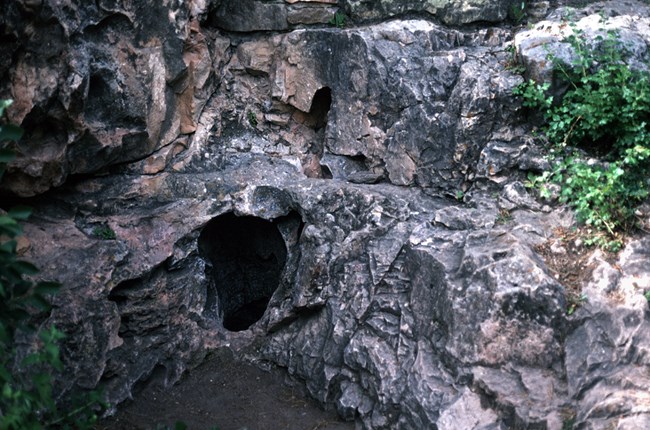
NPS photo Man-Made Cave OpeningsArtificial entrances to the cave caused the cave's climate to change by allowing increased airflow through the passages. The most dramatic effect of climate change was a rock fall at the walk-in entrance caused by freezing and thawing. To help control these changes, airlocks were built at all artificial entrances to restore the cave to more natural conditions. Electric LightingElectric lighting in the cave also causes problems. It increases the temperature of the cave and encourages the growth of green plants. The growth of algae can be controlled by turning off the cave lights when no tours are in the cave or by killing it with a spray of weak chlorine bleach. The park recently replaced the wiring and lights in the cave. By using LED (light emitting diode) and compact fluorescent bulbs, the energy consumption related to cave tours was reduced and the new lights have less impact on the cave. At completion, nearly 1,100 LED fixtures were installed. This increased the number of fixtures by 500 lights but decreased our energy consumption by nearly 80%. The new system, designed and installed by park staff, uses light to create visually captivating scenes and highlights the features that the cave is world famous for - mainly boxwork and complexity. LintOver six million people have visited the cave since 1890. Even when everyone is careful not to touch the cave, each visitor causes changes. Everyone sheds clothing fibers, hair, or skin cells while in the cave. This lint accumulates on cave walls and floors near the paved tour paths. The lint may be an unnatural food that allows molds and bacteria to grow. Lint particles from each person are small, but when multiplied by the approximately 100,000 people who visit the cave each year, the result is thick carpets of lint. The park relies on volunteer help to clean the lint. Each year volunteers vacuum and wash parts of the cave. They even dust some sections with small paintbrushes! Changes to Land Above the CaveOne of the most serious concerns about the cave is what lies on the land above it. Roads, parking lots, and buildings change the direction and amount of water seeping underground. Toxic chemicals, such as oils and gas leaking from vehicles and oils from the asphalt in the roadways, have washed into the cave. In 2004 the asphalt was replaced with a concrete parking lot with a filtration system installed below it. The condition of sewage systems and gasoline storage tanks is frequently checked to make sure there are no leaks. Pollutants seeping into the cave can harm cave life, impair crystal growth, and affect our ground water. The PrairieChanges have also been made to the vegetation within the park. Farming, grazing, and re-seeding are some of the ways that people have altered the plant communities. More than 100 species of non-native species are present in the park. These plants can out-compete or replace the native plants which animals need for food. Controlling these exotic plants by mowing or pulling can be labor intensive. Using chemicals on the exotic species might harm the cave or the groundwater. For some exotic plants, park managers have used a method called bio-control. This involves importing insects that feed on specific plants, such as leafy spurge. Any type of control on exotic plants is difficult because seeds are constantly being carried into the park by wind, birds, mammals, and vehicles. Animal PopulationsMaintaining the natural balance within the park is an ongoing challenge because of the many changes that have occurred within the system. The animal community has never returned to the balance of the mid-1800s. Bison, pronghorn, and elk were all reintroduced to the park in the early 1900s. At first, not enough land was available for these wide-roaming animals. They had to be fed, became victims of disease, and in the case of the pronghorn, were easy targets for predators. The park’s first response in 1916 was to kill hundreds of predators. The Role of FireFire is a natural force that has shaped and reshaped the area’s ecosystem. But because the park is small, park managers cannot let lightning-caused fires burn unchecked. However, without frequent fires, the ponderosa pine forest would take over the grasslands and the bison, pronghorn, and prairie dogs would find their habitats shrinking. Without fire, the increasing number of ponderosa pine trees would use water that would naturally flow into streams or sink into the cave. Continued plant growth would also increase the “fuels” that could cause more intense fires. Because fire is important in maintaining a healthy ecosystem, the park staff burns small areas of the park each year. This is called a prescribed burn. The weather conditions must be right, the wind relatively calm, and a complete crew of fire fighters must be present. |
Last updated: September 3, 2023
